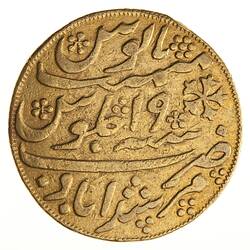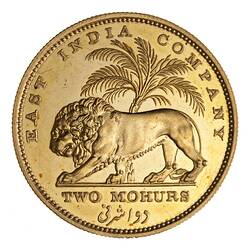Summary
1 Mohur, Issued by Bengal, India, frozen date1202-19
Minted by Calcutta
Obverse Description
Persian couplet (Pridmore 11) (translation: Defender odf the religion of Muhammad. Shah Alam. Emperor. Shadow of the divine favour, put his stamp on the seven climes. 1202)
Reverse Description
Persian Julus formular (Pridmore 13) translation: Struck at the mint of Murshidabad in year 19 of his reign of tranquil prosperity)
Edge Description
milled \\\
Significance
The new coinage was accompanied by the following notice issued at Fort William on 21 July 1790: "The Governor General in Council has directed NOTICE be given that his Lordship has been pleased to revoke the Order that was passed on 3rd December 1788 for suspending the Coinage of Gold Mohurs at the Mint, and that from and after the 1st of next Month, August, Gold Bullion will be received there for that purpose and coined without charge to Individuals.
It is further hereby NOTICED that from and after the 1st of such Month new Milled Gold Money will be issued, of the former Weight and standard, and the Gold now extant of the Calcutta Coinage will be recoined, on application at the Mint, into Gold Mohurs of the New Coinage, also into small money, that is, into Halves and Quarters for the Convenience of Individuals, without and Expence to them, and Weight will be delivered for Weight.
The New Gold Coin will be received by Collectors of the Revenue and Other Officers of Government in payment of the Demands of the Company."
Production did not, in fact, begin until 1 September 1790. The Hirjri and Julus dates on these coins were frozen. In 1819 the weight of the mohur was increased as part of a move towards a uniform coinage. This coin belongs to the next issue which began in 1825 with the edge milled left. It in turn was replaced in 1830 by a type with a crescent mint mark.
More Information
-
Collection Names
-
Collecting Areas
-
Acquisition Information
Transfer from Melbourne Branch of Royal Mint, 11 Jan 1978
-
Date Issued
1825 AD
-
Issued By
-
Mint
-
Denomination
-
Series
-
Material
Gold
-
Axis
12
-
Classification
-
Category
-
Discipline
-
Type of item
-
Dimensions
27.5 mm (Outside Diameter), 12.25 g (Weight)
-
Shape
Round
-
References
Pridmore 83
[Book] Bruce, Colin R. 2007. Standard Catalogue of World Coins 1701 - 1800.
[Book] Pridmore, Fred. 1975. The Coins of the British Commonwealth of Nations, Part 4, India. 1., Vol.1 p. 234 Pages
-
Keywords
British Commonwealth Coins, British Commonwealth and Empire Coins





